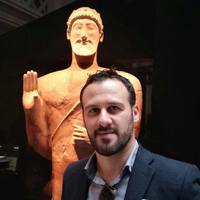Books by Jutta Stroszeck
Panathenäische Preisamphoren hellenistischer Zeit. Kontinuität und Wandel einer athenischen Vasengattung.Beiträge zur Archäologie Griechenlands Band 7, 2022
About Panathenaic prize Amphorae of the Hellenistic Period
Heiligtümer im Bereich von Stadtmauern und Stadttoren, 2022
The edited volume presents research on sanctuaries and cults at or near ancient city gates and wa... more The edited volume presents research on sanctuaries and cults at or near ancient city gates and walls. The papers (among others, by Leda Costaki, Evgenia Vikela, Vassilis Lambrinoudakis, Thomas Schattner, Ute Kelp, Torsten Mattern, Klaus Müller and Torben Keßler) were given at a conference on the occasion of the Jubilee of the Kerameikos excavation on April, 8th, 2014. It appeared in the Athenaia series as vol. 12.
H. Frielinghaus - J. Stroszeck - P. Valavanis (eds.), Griechische Nekropolen. Neue Forschungen und Funde, 2019
The volume contains 21 articles presenting recent finds from Greek necropoleis. The papers were p... more The volume contains 21 articles presenting recent finds from Greek necropoleis. The papers were presented at an international conference organized at Mainz University in November 2016.
This is the updated version of the Kerameikos guidebook that appeared in 2014, translated into Gr... more This is the updated version of the Kerameikos guidebook that appeared in 2014, translated into Greek by D. Donos; editing: M. Jannopoulou and Chrysanthi Kallini.
The Kerameikos is one of the most romantic archaeological sites in Athens. The Athenian grave mon... more The Kerameikos is one of the most romantic archaeological sites in Athens. The Athenian grave monuments preserved there were mostly created during the 5th and 4rth centuries BC. They once belonged to the democratic citizens of Athens and their contemporaries. Many of the marble grave monuments are still on the site. The systematic planting of the area makes it a beautiful biotope that inspired many writers. This book presents a unique collection of the poet's views on the Kerameikos.
The volume presents recent research about sanctuaries und cults in ancient Greece. Ten articles t... more The volume presents recent research about sanctuaries und cults in ancient Greece. Ten articles treat finds from the Spartan Amyklaion, the sanctuaries of Demeter at Marmara in Aigeira, of Asklepios in Pheneos, of Artemis Lykoatis in Arcadia, a new sanctuary at Alikyrna in Aetolis, the cult of the sungod at Delphi, cults on the island of Salamis as well as research about the shrines of Eileithyia and Aphrodite Pandemos and the sanctuary of Artemis Soteira in ancient Athens.
Papers by Jutta Stroszeck
, in: Ümit Aydinoğlu - A. Kaan Şenol (Hrsg.), Olive Oil and Wine Production in Aegean and Mediterranean in Antiquity, International Symposium Proceedings, Bodrum, Turkey, 24-26 November 2022 (Ankara 2024), 2024
The article presents the olive oil mill in the Athenian Kerameikos, situated along the way that l... more The article presents the olive oil mill in the Athenian Kerameikos, situated along the way that led to the olive groves of the Academy

P. Klingborg (Hrsg.), Going Against the Flow. Wells, Cisterns and Water in Ancient Greece. Kolloquium at the Swedish Institute at Athens 2017-2018. Skrifter utgivna av Svenska Institutet i Athen. Acta Instituti Atheniensis Regni Sueciae ser. 8, Bd. 23 (Stockholm 2023) 96-121 , 2023
Despite the prevalent picture of the water supply in the ancient world as being dominated by foun... more Despite the prevalent picture of the water supply in the ancient world as being dominated by fountains and aqueducts, the large number of excavated wells and cisterns show that these were the primary water sources for most individuals. Yet, little research has been done on their construction, function and use. This prompted the organization of the workshop Going against the flow. Wells, cisterns and water in ancient Greece, held at the Swedish Institute at Athens on 28-29 September 2017, and subsequent publication of the contributions in this volume. The ten papers presented here offer new evidence as well as a wide range of new perspectives on the use and function of wells and cisterns in ancient Greece. Considering the ubiquity of these installations in every type of setting during antiquity, from pan-Hellenic sanctuaries and civic centres to domestic workshops and remote farmhouses, it is hoped that the breadth of interest among the authors will allow other scholars to advance their own work further, illuminating new and exciting aspects of life in ancient Greece.
José Miguel Noguera Celdrán, Isabel Rodà de Llanza y Pedro David Conesa Navarro (eds.), Oἰκουμένη Studi di archeologia classica in omaggio a Margherita Bonanno, 2024
A new find of an ancient Greek identification badge of Lokríon, an Athenian official of the 4th c... more A new find of an ancient Greek identification badge of Lokríon, an Athenian official of the 4th century BCE is presented in this article.
e-Jahresberichte DAI, 2023
DAI Cluster 3 – Body and Death: Report on the 2023 work and the international conference organize... more DAI Cluster 3 – Body and Death: Report on the 2023 work and the international conference organized in Athens, October 2023
e-DAI Jahresbericht, 2023
Yearly Presentation of the work: 2023 Deutsches Archäologisches Institut Abt. Athen, Kerameikosgr... more Yearly Presentation of the work: 2023 Deutsches Archäologisches Institut Abt. Athen, Kerameikosgrabung
AtheNea, 2024
My article on p. 102-107 presents some of the results of the field work 2022-2023 in the Athenian... more My article on p. 102-107 presents some of the results of the field work 2022-2023 in the Athenian Kerameikos. In this research program, we explore Athenian topography patterns just outside the city walls. The years 2022-2023 brought a better understanding of the structures in front of the stretch of Athenian city walls to the southwest of the Sacred Street. Features include water managing devices and a symposion room, but many questions arised by these finds need further exploration.
E-Forschungsberichte , 2023

International Symposium Olive Oil And Wine Production in The Aegean and Mediterranean in Antiquity: Rural Settlements, Urban Centers and Trade, 2022
The Athenian Kerameikos site is well known for the well preserved tombs of the classical period a... more The Athenian Kerameikos site is well known for the well preserved tombs of the classical period and also for being part of the deme of the potters that had their workshops in this area northwest of the city. The necropoleis extend alongside the streets leading from the city of Athens towards the countryside, to the harbours and on to other poleis. Apart from tombs and potter’s workshops, also a number of other workshops has been identified on the site. In 2020, an area between two potter’s workshops (indicated by kilns) was investigated on the southwestern side of the street leading from the Dipylon gate towards the Academy, where a famous sacred olive grove was situated. This area had been excavated before, but the structures found had remained enigmatic. During the 2020-2021 field seasons, the structures were re-excavated, cleaned and documented. All details point to the use as an olive mill. As the structures were built over in 403 BC by part of the tombs of the Lacedaimonians, they are securely dated to the 5th century BC. The neighbourhood with potters who could easily use the waste from the oil mill for fuelling their kilns is a pattern that can be seen until today in Greek areas with a strong potter’s production tradition, like Siphnos or Lesbos.
This new interpretation sheds new light on ancient olive oil production techniques and also, it opens the way for a re-evaluation of olive oil production in and around Athens as one of the most powerful economic and cultural resources for Athens.
e-Forschungsberichte, Apr 25, 2017
Rezension zu: Jan Breder, Attische Grabbezirke klassischer Zeit. Philippika. Marburger altertumsk... more Rezension zu: Jan Breder, Attische Grabbezirke klassischer Zeit. Philippika. Marburger altertumskundliche Abhandlungen, Band 60. Verlag Harrassowitz, Wiesbaden 2013. XII und 390 Seiten, darunter 107 Tafelseiten mit 275 Abbildungen, 2 Tabellen.











Uploads
Books by Jutta Stroszeck
Papers by Jutta Stroszeck
This new interpretation sheds new light on ancient olive oil production techniques and also, it opens the way for a re-evaluation of olive oil production in and around Athens as one of the most powerful economic and cultural resources for Athens.
This new interpretation sheds new light on ancient olive oil production techniques and also, it opens the way for a re-evaluation of olive oil production in and around Athens as one of the most powerful economic and cultural resources for Athens.
Archaeological fieldwork in Greece was formed during the 19th century, and it was coined by great men: Ernst Curtius excavated at Olympia, Heinrich Schliemann at Troy, Mycene and Orchomenos, Wilhelm Dörpfeld at Olympia, Carl Blegen at Pylos and Troy and Humfry Payne at Perachora.
In the Kerameikos excavation, the famous Greek archaeologists Athanasios Rhousopoulos and Stefanos A. Koumanoudis were protagonists before the excavation was handed over to the German Archaeological Institute in Athens, where Alfred Brueckner became the first archaeologist working for the GAI there from 1914.
Archaeology in the 19th century also was an Elite business as it was investigating elite sites. This is clearly shown by the interest of Royals such as Elisabeth (“Sissi”) from Austria for the mythology and archaeology of Kerkyra or the funding of the Olympia Excavations by the German Kaiser. Women were rarely represented in both German and Greek (and international) archaeology, despite the fact that there was a wide female interest on archaeological matters in Greece ever since the daughter of Friedrich Carl von Savigny in 1834 wrote vivid letters from Greece about the Mycenian palace of Tiryns. During the late 19th and early 20th centuries, the Kerameikos became a spot of interest attracting also female celebrities like Virginia Woolf. Yet, until after the Second World war, few women worked for the DAI in Athens.
This has changed rapidly since. Today, not only the second female in a row is field director at the Kerameikos site, but also the Institute is directed by a woman since 2014. The talk will present an insight into the structures and reactions that led to this change, it will address questions of gendered archaeological approach and it also will look at society and archaeology taking the Kerameikos site as a case study.
(Vortrag)
Ort: Magdeburg, Universität, Historisches Seminar (Prof. Dr. Martin Dreher),
21. Oktober 2016: Internationaler Workshop zu antiken Fluchtafeln.
June 15th, 2016, 19.00-19.30, Amphitheatre Alkis Argyriakis
Inter-University Program of Post-graduates in Archaeology, City and Architecture
Kommission fuer Alte Geschichte und Epigraphik
des Deutschen Archaeologischen Instituts
Amalienstr. 73 b
D - 80799 Muenchen
Public Lecture about the oracle sanctuary discovered during the 2015 excavation campaign in the Kerameikos in Athens by the German Archaeological Institute, under the direction of Dr. Jutta Stroszeck. The find will be presented, explained and discussed.
Workshop: Krieger*innen im Altertum
Freitag, 5. Mai 2023 Hamburg, Archäologisches Institut